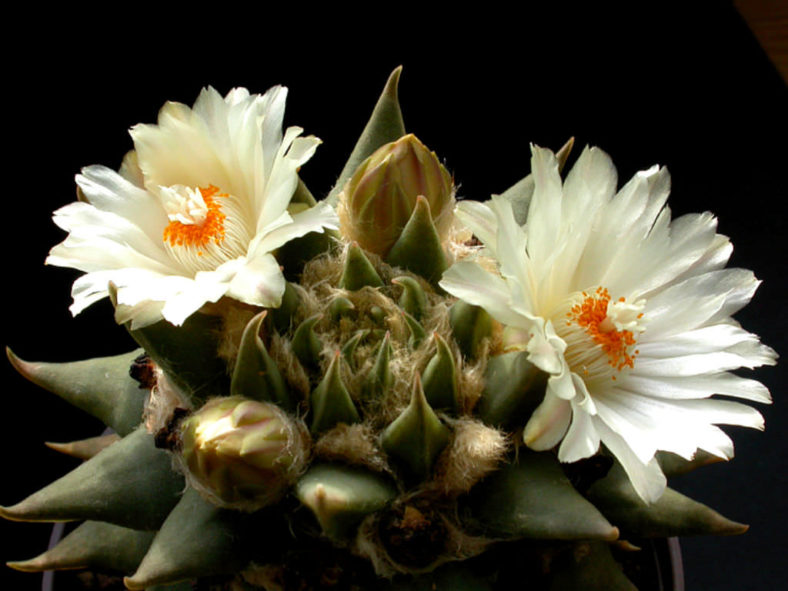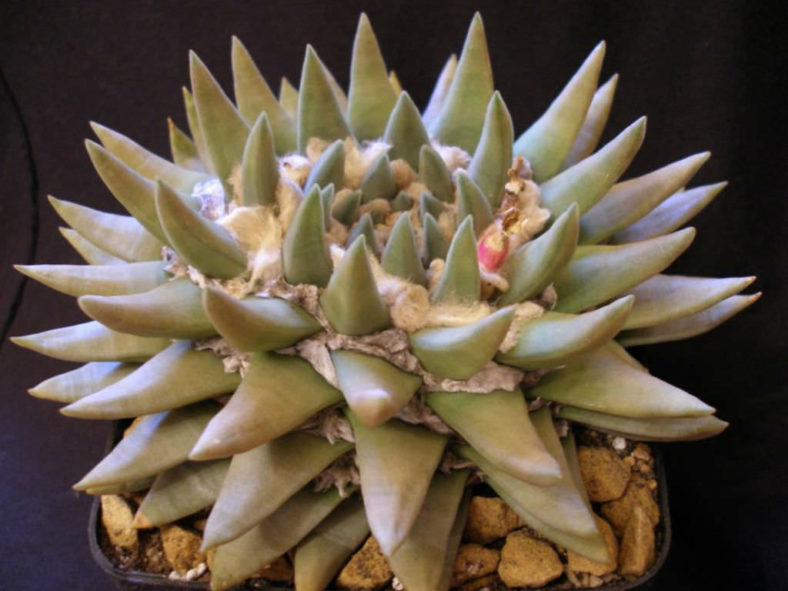Scientific Name
Ariocarpus trigonus (F.A.C.Weber) K.Schum.
Common Name(s)
Living Rock, Star Rock
Synonym(s)
Anhalonium trigonum, Ariocarpus retusus subsp. trigonus, Ariocarpus trigonus var. minor
Scientific Classification
Family: Cactaceae
Subfamily: Cactoideae
Tribe: Cacteae
Genus: Ariocarpus
Etymology
The specific epithet "trigonus" (pronounced "try-GOH-nus") means "trigonal; three-angled; having three angles" and refers to the tubercles of this species, which are sharply triangular on one side and sharply keeled backward to the base.
Origin
Ariocarpus trigonus is native to Mexico. It grows in rocky limestone areas at elevations ranging from 1,970 to 3,940 feet (600 to 1,200 m) in Tamaulipas and Nuevo Leon.
Description
Ariocarpus trigonus, also known as Ariocarpus retusus subsp. trigonus is a slow-growing geophytic cactus with a solitary, yellowish-green stem covered with long, stiff tubercles with woolly bases, resembling a rosette. It is one of the largest species in the genus. The stem is spherical, slightly depressed, and can grow up to 10 inches (25 cm) tall and 12 inches (30 cm) in diameter.
The flowers are cream-colored to yellowish-white or yellow, occasionally with reddish midribs, and appear from late fall to early winter. They can reach a length of 1.8 inches (4 cm) and a diameter of 2 inches (5 cm). The fruits are whitish or greenish, measuring up to 0.8 inches (2 cm) in length and 0.4 inches (1 cm) in diameter.

Hardiness
USDA hardiness zones 9b to 11b: from 25°F (-3.9°C) to 50°F (10°C).
How to Grow and Care
Plant your Ariocarpus in soil specifically formulated for cacti. You can buy a cactus mix at your local nursery. Do not use generic soil mixes, as they will not provide sufficient aeration and drainage. Additionally, using a container without a hole, whether a pot or a terrarium, is a bad idea for the same reason.
Ariocarpus needs a lot of sunlight. However, in hot, dry areas, it can be damaged by excessive sunlight. To protect it, use a shade cloth to limit its exposure to the sun or move it out of the sun during the hottest hours of the day. In more temperate areas, direct sunlight is fine.
These cacti prefer to be kept at room temperature or slightly lower and in low humidity.
Water your Ariocarpus during the growing season, but wait until the entire soil has dried out completely before watering again. The amount of time this takes will vary depending on your climate and the size of your pot, if you use one.
Learn more at How to Grow and Care for Ariocarpus.
Links
- Back to genus Ariocarpus
- Succupedia: Browse succulents by Scientific Name, Common Name, Genus, Family, USDA Hardiness Zone, Origin, or cacti by Genus
Photo Gallery
Click on a photo to see a larger version.


